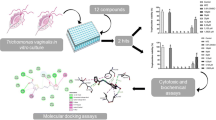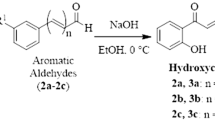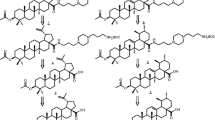Abstract
In the present study, we have identified ten compounds, namely dodecanol acid, myristic acid, neophytadiene, palmitic acid, heptadecanoic acid, linoleic acid, elaidic acid, 3-7-dimethyl acid, stearic acid and methyl eicos acid, of the methanolic extract of Apamarga Kshara by GC–MS analysis. Apamarga Kshara has been reported to be active against cervical erosion. Major causal organism for cervical erosion is Trichomonas vaginalis. However, there is a paucity of information about the mechanism of action and inhibitory effect of the biologically active natural compounds presented in A. Kshara against this organism (T. vaginalis). Therefore, present investigation was conducted to observe possible interactions of these compounds on T. vaginalis carbamate kinase using molecular docking software ‘AutoDock 4.2.’ Identification of the amino acid residues crucial for the interaction between T. vaginalis carbamate kinase and these natural compounds is of due scientific interest. The study will aid in efficacious and safe clinical use of the above-mentioned compounds.











Similar content being viewed by others
References
Lesney MS (2004) Nature’s pharmaceuticals: natural products from plants remain at the core of modern medicinal chemistry. TCAW 13:26–31
Chang AR (1991) Erosion of the uterine cervix; an anachronism. Aust N Z J Obstet Gynaecol 31:358–362
Critchlow CW, Wolner-Hanssen P, Eschenbach DA, Kiviat NB, Koutsky LA, Stevens CE, Holmes KK (1995) Determinants of cervical ectopia and of cervicitis: age, oral contraception, specific cervical infection, smoking, and douching. Am J Obstet Gynecol 173:534–543
Goldacre MJ, Loudon N, Watt B, Grant G, Loudon JD, McPherson K, Vessey MP (1978) Epidemiology and clinical significance of cervical erosion in women attending a family planning clinic. Br Med J 1:748–750
Wright KO, Mohammed AS, Olatunji OS, Kuyinu YA (2014) Cervical Ectropion and Intra-Uterine Contraceptive Device (IUCD): a five-year retrospective study of family planning clients of a tertiary health institution in Lagos Nigeria Kikelomo Ololade. BMC Res Notes 7:946
Li H, Gao Z, Kang L, Zhang H, Yang K, Yu K, Luo X, Zhu W, Chen K, Shen J, Wang X, Jiang H (2006) TarFisDock: a web server for identifying drug targets with docking approach. Nucleic Acids Res 34:219–224
Meena P, Gaurav P (2014) Case report role of Ksharakarma in recurrent cervical erosion: a case study. J Ayurveda Holist Med 2:60–63
Gupta P (2014) Clinical evaluation of the efficacy of Kshara karma with Apamarga kshara and Jatyadi taila pichu in the management of cervical erosion (karnini yonivyapad). 5th world ayurvedic congress and arogya expo. Abstract ID 10719
Naama JK, Kadhum TJ, Ismael I (2008) Study of Causative Agents of Cervicitis in Women Attending Gynecologic Outpatient Department in Najaf City. Kufa Med J 11:166–174
Edwards MR, Schofield PJ, O’Sullivan WJ, Costello M (1992) Arginine metabolism during culture of Giardia intestinalis. Mol Biochem Parasitol 53:97–103
Schofield PJ, Edwards MR, Matthews J, Wilson JR (1992) Arginine metabolism during culture of Giardia intestinalis. Mol Biochem Parasitol 51:29–36
Galkin A, Kulakova L, Wu R, Nash TE, Dunaway-Mariano D, Herzberg O (2010) X-ray structure and characterization of carbamate kinase from the human parasite Giardia lamblia. Acta Crystallogr Sect F 66:386–390
Daayf F, Schmitt A, Belanger RR (1997) Evidence of phytoalexins in cucumber leaves infected with powdery mildew following treatment with leaf extracts of Reynoutria sachalinensis. Plant Physiol 113:719–727
Vimalavady A, Kadavul K (2013) Phytocomponents identified on the various extracts of stem of Hugonia mystax L. (Linaceae). Eur J Exp Biol 3(1):73–80
Dubal KN, Ghorpade PN, Kale MV (2013) Studies on bioactive compounds of Tectaria coadunata (Wall. Ex Hook. & Grev.) C. Chr. Asian J Pharm Clin Res 6(2):186–187
Ramazan M, Pinar I, Havser EV (2011) Antioxidant activity and total phenolic content of Gagea fibrosa and Romulea ramiflora. Iran J Chem Chem Eng 30(3):57–62
Shakil S, Khan AU (2010) Interaction of 2009 CTX-M variants with drugs and inhibitors: a molecular modelling and docking study. J Proteomics Bioinform 3:130–134
Greenblatt HM, Dvir H, Silman I, Sussman JL (2003) Acetylcholinesterase: a multifaceted target for structure-based drug design of anticholinesterase agents for the treatment of Alzheimer’s disease. J Mol Neurosci 20:369–383
Acknowledgments
Shaikh S. is supported by INSPIRE grant from Department of Science and Technology, New Delhi, India (Grant No. IF130056), which is sincerely acknowledged. Shazi Shakil thanks all of the staff of Center of Innovation in Personalized Medicine (CIPM), King Abdulaziz University, Saudi Arabia, for continued support. The authors are thankful to Advanced Instrumentation Facility, University Science Instrumentation Centre, JNU, New Delhi, India, for the GC–MS analysis of the sample.
Author information
Authors and Affiliations
Corresponding author
Ethics declarations
Conflict of interest
The authors declare no potential conflict of interest with respect to the research, authorship and/or publication of this article.
Electronic supplementary material
Below is the link to the electronic supplementary material.
Rights and permissions
About this article
Cite this article
Shaikh, S., Aaqil, H., Rizvi, S.M.D. et al. Comparative Inhibition Study of Compounds Identified in the Methanolic Extract of Apamarga Kshara Against Trichomonas vaginalis Carbamate Kinase (TvCK): An Enzoinformatics Approach. Interdiscip Sci Comput Life Sci 8, 357–365 (2016). https://doi.org/10.1007/s12539-015-0120-0
Received:
Revised:
Accepted:
Published:
Issue Date:
DOI: https://doi.org/10.1007/s12539-015-0120-0




